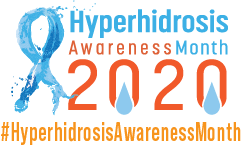We kick off Hyperhidrosis Awareness Month with a look at the ABCs of Hyperhidrosis Diagnosis:
There are two types of hyperhidrosis (Hh): primary and secondary.
Secondary Hh is sweating that is caused by or is a symptom of another underlying medical condition or is a side effect of a medication. Ruling out secondary hyperhidrosis (or responding to secondary Hh appropriately) is the first step in Hh management. After this has been done, a diagnosis of primary (or idiopathic) Hh can be solidified using the ABCs, below.
A: Age of onset – Primary Hh usually begins during childhood or adolescence.
B: Bilateral – Hh sufferers typically experience bilateral (on both sides of the body), symmetric, focal involvement of palms, feet, face/scalp, and/or axillae (or other specific body areas or body area combinations).
C: Cessation during sleep – Patients with primary Hh usually do not sweat excessively during sleep.
D: Duration – For a primary Hh diagnosis, look for excessive sweating symptoms or episodes (2 or more per week) that started 6+ months ago and appear to be chronic.
E: Episodes – Extreme, uncontrollable sweating will likely not be continuous or constant for primary Hh patients.
F: Family – 2/3rds of primary Hh sufferers indicate other family members have Hh, too.
G: Gets in the way – Some level of sweating and increased sweating is to be expected in life. Hh, however, gets in the way of sufferers’ ability to function, participate in school and athletics, work comfortably and at their fullest potential, have fun, pursue dreams, develop relationships, and more. Further, it has been shown that Hh has a deep impact on the mental health of patients, especially its youngest sufferers.
Brought to you by the International Hyperhidrosis Society.
Did you enjoy this article? Find more on Medical Dermatology topics here.


